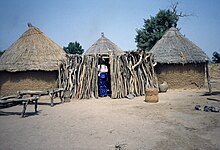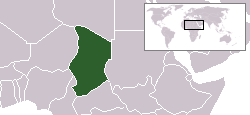| WARNING: Chad has experienced several bouts of political turmoil and jihadist activity in the past few years and, although the security situation has slowly improved since 2010, the UK and U.S. governments advise against all but essential travel to Chad. Anywhere outside the capital, N'Djamena, is highly dangerous, especially in the north and east—where special travel/movement permits are necessary. Travel overland between Chad and Sudan, South Sudan, the CAR, Niger, & Libya is dangerous and highly discouraged. There is also a fairly high level of violent crime in much of the country. (Updated June 2013) | |
Chad (French: Tchad) is one of the poorest and most corruptly mis-governed countries in the world, with most of its inhabitants living in poverty as subsistence herders and farmers.
It shares a short border with Nigeria and is landlocked in the Sahel, south of Libya, east of Niger and Cameroon, north of the Central African Republic, and west of Sudan.
Due to its distance from the sea and desert climate, Chad is sometimes described as the "Dead Heart of Africa".
Regions

Cities
Understand
History
For more than 2000 years, the Chadian Basin has been inhabited by agricultural and sedentary peoples. The earliest of these were the legendary Sao, known from artefacts and oral histories. The Sao fell to the Kanem Empire, the first and longest-lasting of the empires that developed in Chad's Sahelian strip by the end of the 1st millennium AD. The power of Kanem and its successors was based on control of the trans-Saharan trade routes that passed through the region.
French colonial expansion led to the creation of the Territoire Militaire des Pays et Protectorats du Tchad in 1900. By 1920, France had secured full control of the colony and incorporated it as part of French Equatorial Africa. The French primarily viewed the colony as an unimportant source of untrained labour and raw cotton. The colonial administration in Chad was critically understaffed and had to rely on the dregs of the French civil service.
Fifteen thousand Chadian soldiers fought for Free France during WWII and after the war ended, France granted Chad the status of overseas territory and its inhabitants the right to elect representatives to both the French National Assembly, and to a Chadian assembly. Chad was granted independence on 11 August 1960 with the PPT's leader, François Tombalbaye, as its first president. Two years later, Tombalbaye banned opposition parties and established a one-party system. In 1965 Muslims began a civil war. Tombalbaye was overthrown and killed in 1975, but the insurgency continued. In 1979 the rebel factions conquered the capital, and all central authority in the country collapsed. The disintegration of Chad caused the collapse of France's position in the country, and a civil war in which the Libyans (unsuccessfully) became involved.
A semblance of peace was finally restored in 1990. The government eventually drafted a democratic constitution, and held flawed presidential elections in 1996 and 2001. In 1998, a rebellion broke out in northern Chad, which sporadically flares up despite several peace agreements between the government and the rebels. In 2005 new rebel groups emerged in western Sudan and have made probing attacks into eastern Chad. Power remains in the hands of an ethnic minority. In June 2005, President Idriss Deby won a referendum to remove constitutional term limits. In February 2008, an attempted coup rocked the capital.

Climate
Each year a tropical weather system known as the inter-tropical front crosses Chad from south to north, bringing a wet season that lasts from May to October in the south, and from June to September in the Sahel.
Landscape
Broad, arid plains in the centre, desert in the north, mountains in the northwest, lowlands in the south. Lowest point: Djourab Depression (160 m/525 ft). Highest point: Emi Koussi (3,415 m/11,204 ft).
The dominant physical structure is a wide basin bounded to the north, east and south by mountain ranges such as the Ennedi Plateau in the north-east. Lake Chad, after which the country is named, is the remains of an immense lake that occupied 330,000 km2 (205,000 mi2) of the Chadian Basin 7,000 years ago. Although in the 21st century it covers only 17,806 km2 (11,064 mi2), and its surface area is subject to heavy seasonal fluctuations, the lake is Africa's second largest wetland.
Get in
Visa
Citizens of the following countries do not require a visa: Benin, Burkina-Faso, Cameroon, Republic of Central Africa, Congo, Ivory Coast, Gabon, Equatorial Guinea, Mauritania, Niger and Senegal.
For all others, a visa is necessary. A single-entry visa costs US$100 for 1 month and multiple-entry visas cost US$150 (3 months) or US$200 (6 months). A letter of invitation is required.
By plane

Air France has daily flights from Paris to N'Djaména. Ethiopia Airlines flies to Addis Ababa, Turkish airlines to Istanbul, Royal Air Maroc to Casablanca, Sudan Airways to Khartoum, Egypt Air to Cairo, Camair-co to Douala.
By train
There are no usable rail links.
By car
|
Libya "temporarily" closed its land border with Chad on 16 December, 2012. It is unclear when the border will reopen. |
Roads are disrepair and are typically unpaved - there is only one paved road, which currently runs from Massakory in the north through N'Djamena on to Guelendeng, Bongor, Kelo and Moundou. It is the best road in the country but still has numerous potholes and runs through the centre of a number of small villages and drivers should exercise caution and moderate speeds even while on the main road.
There are several border crossings with Cameroon, most notably via Kousseri near N'Djamena and near the towns of Bongor and Lere. Be very careful, drive defensively, don't stop unless there is a very good reason. Do not drive at night, as coupeurs de route (road bandits) are common. They are a particular concern along the two roads leading out of Guelendeng, towards Ba-Illi (where ex-pats were attacked in two separate incidents in 2005, resulting in the death of one Catholic nun) and towards Bongor.
By bus

By boat
It is impossible to reach Chad by boat unless crossing illegally through Lake Chad.
Get around

Talk
The main languages of Chad are French and Arabic. Few Chadians other than the educated and well-travelled speak literary Arabic, however; a dialect of Arabic known as "Chadian Arabic" is much more widely spoken and is the closest thing the country has to a trade language. Chadian Arabic is significantly different from Literary Arabic, but similar to the dialects of Sudan and Egypt. Literary Arabic speakers can typically understand Chadian Arabic but the reverse is not true. There are over one hundred indigenous languages also spoken.
See
- Oasis of Faya (or Faya-Largeau)
- Lake Chad
- National Museum
- Gaoui
- Ennedi
Do

Parc National de Zakouma
Buy

The Central African CFA franc (XAF) is used by Chad. It is also used by Cameroon, Central African Republic, Republic of the Congo, Equatorial Guinea and Gabon. While strictly a separate currency from the Western African CFA franc (XOF), the two currencies are used interchangeably at par throughout all CFA franc (XAF & XOF) using countries.
Both CFA francs are guaranteed by the French treasury and are pegged to the euro at €1 = XAF655.957
There are no restrictions on bringing foreign currencies into Chad. US dollars and euros are often directly accepted in payment.
Eat
Meat dishes are very popular in Chad, and foreign travellers speak highly of the meat (such as lamb). Food is usually eaten without utensils, and hand sanitizer may be a good precaution. Muslims find it offensive to eat with the left hand. If eating with or being served by Muslims in Chad, be sure to eat with your right hand only.
Follow common health travel guidelines concerning raw fruit and cooking requirements to avoid disease. The US State Department website has resources concerning safety while eating abroad.
Because the colonial occupier of Chad (or Tchad) was France, you can easily use euros, too. But for most, Chad is an expensive place compared to the rest of Africa.
Drink
Sleep

Years ago few hotels existed in Chad, but now N'Djamena hosts a myriad of affordable options.
Stay safe
Chad is consistently engulfed in political turmoil and attacks from rebels will probably not happen, but are certainly a reality. The situation has stagnated, but it remains a threat. Violence from the Darfur conflict is pouring into Eastern Chad from Sudan, a country which shares hostilities with Chad. Any activity outside of N'Djamena is done with difficulty at best. Northern Chad is barren, scorching desert and guides (good luck) and meticulous planning are required. In 2013, Boko Haram jihadists were spotted in Chad.
N'Djamena is RELATIVELY safe, although one should be wary of petty street crime and corrupt police/officials. Most border crossings are extremely difficult (Sudan and Libya not being a viable option) although the border crossings with Niger and Cameroon are relatively painless.
Stay healthy
Don't accept water from any stores unless you know the brand. Eat only your own food that you buy in grocery stores. Avoid restaurants whenever possible. Stay away from people that look sick; there are many diseases in Chad to beware of. If you are in Chad for a while, go to a doctor once a month if you can afford it.
Respect
|
Ramadan Ramadan is the 9th and holiest month in the Islamic calendar and lasts 29–30 days. Muslims fast every day for its duration and most restaurants will be closed until the fast breaks at dusk. Nothing (including water and cigarettes) is supposed to pass through the lips from dawn to sunset. Non-Muslims are exempt from this, but should still refrain from eating or drinking in public as this is considered very impolite. Working hours are decreased as well in the corporate world. Exact dates of Ramadan depend on local astronomical observations and may vary somewhat from country to country. Ramadan concludes with the festival of Eid al-Fitr, which may last several days, usually three in most countries.
If you're planning to travel to Chad during Ramadan, consider reading Travelling during Ramadan. |
There are 200 distinct ethnic groups. In the north and center: Arabs, Gorane (Toubou, Daza, Kreda), Zaghawa, Kanembou, Ouaddai, Baguirmi, Hadjerai, Fulbe, Kotoko, Hausa, Boulala, and Maba, most of whom are Muslim; in the south: Sara (Ngambaye, Mbaye, Goulaye), Moundang, Moussei, Massa, most of whom are Christian or animist; about 1,000 French citizens live in Chad.
The Chadian-Libyan conflict is something to be avoided at all times; Chadians known to be living in Libya have been tortured and murdered on previous occasions.
Connect

